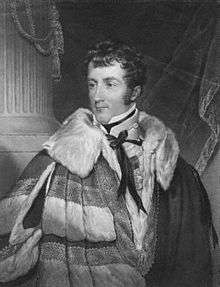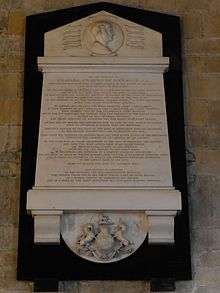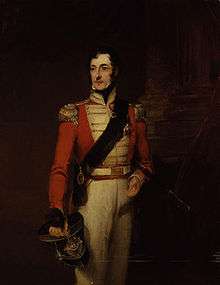Charles Gordon-Lennox, 5th Duke of Richmond
Charles Gordon-Lennox, 5th Duke of Richmond, KG, PC (3 August 1791 – 21 October 1860), of Goodwood House near Chichester in West Sussex, was a British peer, soldier and prominent Conservative politician.
His Grace The Duke of Richmond and Lennox KG, PC | |
|---|---|
 The Duke of Richmond, 1824. | |
| Postmaster General | |
| In office 11 December 1830 – 5 July 1834 | |
| Monarch | William IV |
| Prime Minister | The Earl Grey |
| Preceded by | The Duke of Manchester |
| Succeeded by | The Marquess Conyngham |
| Personal details | |
| Born | 3 August 1791 Richmond House, Whitehall Gardens, London |
| Died | 21 October 1860 (aged 69) Portland Place, Marylebone, London |
| Nationality | British |
| Political party | Ultra-Tories |
| Spouse(s) | Lady Caroline Paget (1796–1874) |
| Children |
|
| Parents | Charles Lennox, 4th Duke of Richmond Lady Charlotte Gordon |
| Alma mater | Trinity College, Dublin |


Origins
He was born "Charles Lennox", the son and heir of Charles Lennox, 4th Duke of Richmond (1764-1819) by his wife Lady Charlotte Gordon, the eldest child of Alexander Gordon, 4th Duke of Gordon. Until his father's death in 1819 he was styled Earl of March, a courtesy title, being one of his father's subsidiary titles.
Education
He was educated at Westminster School in London and Trinity College, Dublin.[1]
Military career

As Earl of March, he served on Wellington's staff in the Peninsular War,[2] during which time he volunteered to join the 52nd (Oxfordshire) Regiment of Foot's advance storming party on the fortress of Ciudad Rodrigo.[3] He formally joined the 52nd Foot in 1813 and took command of a company of soldiers at the Battle of Orthez in 1814, where he was severely wounded; the musket-ball in his chest was never removed.[1][3] During the Battle of Waterloo (1815) he was aide-de-camp to the Prince of Orange, and following the latter's wounding, served as aide-de-camp to Wellington.[4] He was chiefly responsible for the institution in 1847 of the Military General Service Medal for all survivors of the campaigns between 1793 and 1814, considered by many belated as hitherto there had only been a Waterloo Medal. He campaigned in Parliament and also enlisted the interest of Queen Victoria.[5] Richmond himself received the medal with eight clasps.[3]
On 19 October 1817 he reformed the Goodwood Troop of Yeomanry Artillery, originally raised by the 3rd Duke in 1797. The unit supported the cavalry of the Sussex Yeomanry but was disbanded in December 1827.[6] Richmond was appointed Colonel of the Royal Sussex Light Infantry Militia on 4 December 1819, and Colonel-in-Chief of its offshoot the Royal Sussex Militia Artillery, on its formation in April 1853.[7]
Political career
Richmond sat as a Member of Parliament for Chichester between 1812 and 1819.[2] The latter year he succeeded his father in the dukedom and entered the House of Lords where he was a vehement opponent of Roman Catholic emancipation, and later was a leader of the opposition to Peel's free trade policy, as he was the president of the Central Agricultural Protection Society, which campaigned for preservation of the Corn Laws. Although a vigorous Conservative and Ultra-Tory for most of his career, Richmond's anger with Wellington over Catholic Emancipation prompted him to lead the Ultras into joining Earl Grey's reforming Whig government in 1830 (Lang, 1999).[2] He served under Grey as Postmaster General between 1830 and 1834.[1] He was sworn of the Privy Council in 1830.[8] Richmond was Lord Lieutenant of Sussex between 1835 and 1860 and was appointed a Knight of the Garter in 1829.[1][9]
In 1836, on inheriting the estates of his childless maternal uncle George Gordon, 5th Duke of Gordon, he was required by the terms of the bequest to assume the surname of Gordon before that of Lennox.[2][10]
Marriage and children
On 10 April 1817 he married Lady Caroline Paget (1797-March 1874), a daughter of Henry Paget, 1st Marquess of Anglesey by his wife Lady Caroline Villiers, by whom he had five sons and five daughters, including:
Sons
- Charles Gordon-Lennox, 6th Duke of Richmond (1818–1903), eldest son and heir;
- Fitzroy George Charles Gordon-Lennox (11 June 1820 – March 1841), lost at sea aboard SS President
- Rt. Hon. Lord Henry Charles George Gordon-Lennox (2 November 1821 – 29 August 1886), married Amelia Brooman and left no children
- Captain Lord Alexander Francis Charles Gordon-Lennox (14 June 1825 – 22 January 1892), married Emily Towneley and left children
- Lord George Charles Gordon-Lennox (22 October 1829 – 27 February 1877), married Minnie Palmer and left no children
Daughters
- Lady Caroline Amelia Gordon-Lennox (18 June 1819 – 30 April 1890), who married John Ponsonby, 5th Earl of Bessborough;
- Lady Augusta Catherine Gordon-Lennox (14 January 1827 – 3 April 1904), who married Prince Edward of Saxe-Weimar (1823–1902);
- Lady Cecilia Catherine Gordon-Lennox (13 April 1838 – 5 October 1910), who married Charles Bingham, 4th Earl of Lucan.
Death and burial
He died at Portland Place, Marylebone, London, in October 1860, aged 69 and was succeeded in the dukedom by his eldest son Charles Gordon-Lennox, 6th Duke of Richmond (1818–1903).
See also
- Duchess of Richmond's Ball
References
- Lundy, Darryl. "thepeerage.com Charles Gordon-Lennox, 5th Duke of Richmond". The Peerage.
-

- Moorsom, W.S. Historical Record of the Fifty-Second Regiment (Oxfordshire Light Infantry), London: Richard Bentley, 1860, p. 443
- Georgiana, Dowager Lady De Ros. Personal Recollections of the Duke of Wellington, The Regency Library, Complimentary Issue Archived 28 August 2007 at the Wayback Machine July 2005. Originally published in Murray's Magazine 1889 Part I.
- Stanley C. Johnson, A Guide to Naval, Military, Air-force and Civil Medals and Ribbons, 1921, pp 57–60
- L. Barlow & R.J. Smith, The Uniforms of the British Yeomanry Force 1794–1914, 1: The Sussex Yeomanry Cavalry, London: Robert Ogilby Trust/Tunbridge Wells: Midas Books, ca 1979, ISBN 0-85936-183-7, p. 7.
- Hart's Army List, 1855.
- leighrayment.com Privy Counsellors 1679–1835
- leighrayment.com Peerage: Rendel-Robson
- "No. 19409". The London Gazette. 12 August 1836. p. 1441.
| Parliament of the United Kingdom | ||
|---|---|---|
| Preceded by George White-Thomas James du Pre |
Member of Parliament for Chichester 1812–1819 With: William Huskisson |
Succeeded by William Huskisson Lord John Lennox |
| Political offices | ||
| Preceded by The Duke of Manchester |
Postmaster General 1830–1834 |
Succeeded by The Marquess Conyngham |
| Honorary titles | ||
| Preceded by The Earl of Egremont |
Vice-Admiral of Sussex 1831–1860 |
Vacant |
| Lord Lieutenant of Sussex 1835–1860 |
Succeeded by The Earl of Chichester | |
| Peerage of England | ||
| Preceded by Charles Lennox |
Duke of Richmond 3rd creation 1819–1860 |
Succeeded by Charles Gordon-Lennox |
| Peerage of Scotland | ||
| Preceded by Charles Lennox |
Duke of Lennox 2nd creation 1819–1860 |
Succeeded by Charles Gordon-Lennox |
| French nobility | ||
| Preceded by Charles Lennox |
Duke of Aubigny 1819–1860 |
Succeeded by Charles Gordon-Lennox |